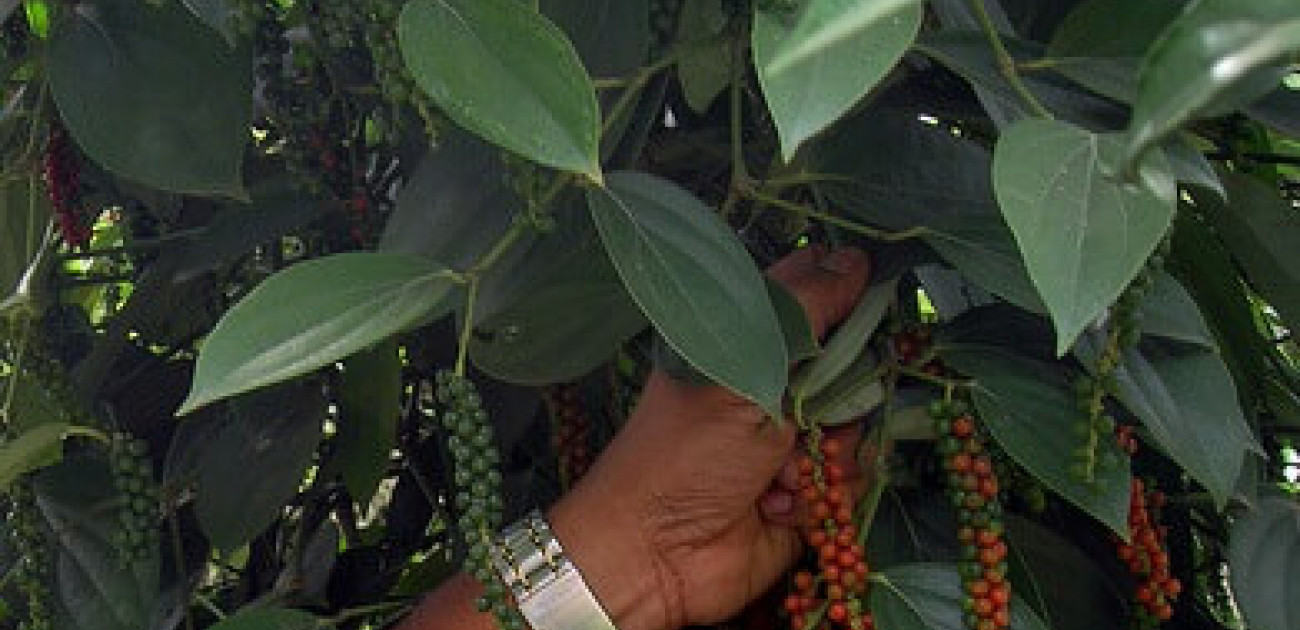02 March 2018
A World Of Pepper
A trip around the world of pepper. Overview of the different types of pepper available from around the world - from black peppercorns to Sichuan pepper, from Indonesian long pepper to Penja white peppercorns from Cameroon.

From records dating back as far as the Ancient Greeks, to its continued prominence as the world’s most traded spice, pepper in all its forms has a colourful and fragrant history.
It is an essential spice in many parts of the world, forming part of the culinary culture of so many countries, as well as being rich in vitamins, minerals and antioxidants.
Piper nigrum is the main family of peppercorns, giving us a variety of different colours and flavours of peppercorn depending on when it is picked and how it is processed. Green peppercorns are under-ripe berries often preserved in brine; black peppercorns are green berries left out to dry and oxidise to a deep brown; white peppercorns are essentially black peppercorns with their outer skins removed. Flavours vary across the different varieties but traditionally the United States preferred black pepper and Europe white, but today pepper in its widest sense is enjoyed by all discerning cooks – and white pepper is much, much less popular than it used to be.
Some pepper growers will leave a small part of the crop to ripen further on the vine, achieving a reddish hue. This is for their own consumption and is “red pepper”. It is more difficult to collect and has a lower crop yield, but has an intensity of flavour unmatched by the other types of pepper. Such red pepper has a special quality, is in limited supply and rare.
Steenbergs sources pepper from carefully selected small producers all over the world. Many of the peppercorns are organic and some also carry the Fairtrade mark. Alongside our range of over 20 different peppers, Steenbergs hand-blends unique pepper mixes, including: Chilli & Pepper; English; Caribbean; West African; Shot Pepper and Venetian. Browse our relaunched website to rekindle your enthusiasm for the world of pepper.
Not only are there many varieties of standard peppercorns, but, also, “false” peppers such as Cubeb and Long Pepper, Pink Peppercorns, Sichuan Pepper, Selim Pepper (or Uda Pods), Mountain Pepper and Grains of Paradise – all of which are used to enhance dishes all over the world. In later blogs, I will discuss the flavours of these different types of pepper.
But for now, here are just a few of the countries from which Steenbergs sources its peppers:
India: the home of the original peppers and still a major world producer, India is home to the excellent Tellicherry and Malabar black peppercorns, named for a port and the coastline in Kerala, Southern India. These have spicy, warming taste that is full of fruity citrus notes.
Indonesia: producer of both the popular white Muntok peppercorns and the bold pungent Lampung black peppercorns from Southern Sumatra, and ‘false’ peppers such as Cubeb Pepper (Piper cubeba), a specialist Indonesian vine with a hot, pungent and sultry smoky flavour, used in Steenbergs’ ras al hanut spice blend; Andaliman, a citrussy and mildly numbing pepper related to Sichuan; and Long Pepper (Piper retrofactum), the dried fruit of a flowering Indonesian vine with a sweet aroma but hot pungent flavour.
Cambodia: home to the specialist Red Kampot and Red Long peppers. Red Kampot is a protected production area and has flavours of vanilla and candied citrus. Red long pepper has an exotic smoky scent and a sweet honey and slightly chocolatey taste.
Vietnam: the world’s leader in production of black pepper, producing 34% of the world’s production, followed by India, Indonesia, Brazil and China. Much of its pepper is very average, but the rare Black Phu Quoc Pepper is worth tracking down – fiery in heat with a sweet scent.
China: growers of the prickly ash tree whose berries make the warm, fragrant Sichuan pepper that starts with a citrus and unripe cherry flavour and ends with a sherbet-like fizz.
Japan: home to the Sansho pepper from the Wakayama province is similar to Sichuan. It has a strong citrussy taste, hints of lemongrass, and and even stronger numbing aftertaste.
Tasmania: the native Tasmanian Mountain Pepperberry (Tasmania lanceolate) produces a ground leaf which has a mild peppery flavour and a very hot, pungent berry that is 10 times hotter than black pepper.
South America: most pink peppercorns, which are not a true pepper, come from a native South American shrub, often grown in Brazil, with a milder flavour than black peppercorns.
West Africa: producer of the hottest white pepper, Penja, from Cameroon. This region produces ‘false’ peppers, such as the smoky Selim pepper from Ghana and Grains of Paradise, a rare type of cardamom with a piney taste used to flavour Belgian beers and Steenbergs’ Qalat daqqa spice blend.
Madagascar: the earthy, woody Voatsiperifery pepper (Piper borbonense) is wild-harvested in the tropical forests of south-east Madagascar. Voatsiperifery has floral woody notes and a peppery taste with hints of fresh citrus.




